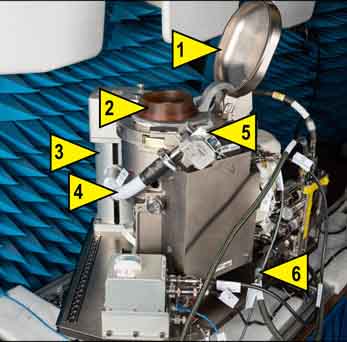
UWMS SpaceToilet
While NASA has officially announced an Artemis Program plans to land the first woman on the moon along with the man again after 48 years (after 1972). The US space agency NASA has developed a state-of-the-art toilet for use on the International Space Station and the moon. This special toilet is made of precious metal titanium.
The new toilet seeks to address the flaws that existed in previous space toilets. The purpose of making the toilet from precious metal is to protect it from possible chemical changes. The toilet weighs 100 pounds and is about 28 inches high. That's half of the Russian-made toilet already installed on the International Space Station. It is not only a toilet but also a complete and small recycling plant. Because disposing of anything in space is not an easy task.
NASA says the construction of the new toilet takes into account future needs. Because flights to take tourists into space are about to begin. And it will require additional and special toilets.
The private sector is now involved in space travel. SpaceX has begun its space travel and flights to take astronauts to the International Space Station. Another aircraft maker, Boeing, is preparing to land next year.
The toilet is part of an 8,000-pound shipment from the United States to the International Space Station. Where its performance will be tested over the next few months. If the experiments are successful, it will be opened for general use.
The toilet seems to be a normal thing. But in space, it is even more important. Because it is not easy to use in case of weightlessness and then disposal of waste is also an important issue.
Urine is also not wasted on the International Space Station. Instead, it is recycled and reusable. The International Space Station is used by astronauts all year round. It is not possible to deliver large quantities of water from the earth to meet their water needs, nor does the space station can store large amounts of water.
Mike Hopkins, a NASA astronaut, says even the simplest and most trivial things in space become difficult, a clear example of which is the use of the toilet. Because there is no gravity in space. Everything becomes weightless and floats.
 |
| Image: NASA |
When a man himself is floating; it difficult to control the floating things. Astronauts are trained to carry out their tasks in a state of weightlessness before being sent on space missions.
Mike Popkins is the commander of SpaceX's second mission, and under his leadership, a spacecraft will depart on October 31.
Shannon Walker is a NASA astronaut. She has spent some time on the International Space Station. Talking to reporters about the new toilet, he said that using the bathroom in space was a difficult experience. I have gone through this experience. According to her, the toilets currently installed at the International Space Station, it causes problems, especially for women. Their design needed to change.
NASA said in a statement that the new toilet will reduce the problems of women astronauts. There are always two or three astronauts on the International Space Station. Sometimes, their number increases to six or seven.
There are two toilets installed on the space station. With the installation of a new toilet, their number will increase to three. The increase in the number of toilets is also important because in the coming years there will be an influx of tourists and amateur astronauts.
Many commercial companies are also interested in space stations and space as a new horizon for their commercial campaigns.
Recently, a cosmetics company has contracted a photoshoot on the space station for its advertising campaign to remove facial wrinkles. It will cost 28 thousand dollars. This will be the first commercial space photoshoot of its kind.
The International Space Station is not a human destination. Rather, it is the first step of a journey into space. Preparations are underway to take tourists to the moon in the coming years. Special recycling toilets will be required for this trip and during the stay on the moon.
How Do The New Space Toilets Work?
In the loss of gravity, space toilets utilize airflow to pull feces and urine away from the body and into the proper containers. A new feature of this toilet is the automatic start of airflow when the toilet cover is lifted, which also benefits with odor control. It also includes a more efficient and comfortable design requiring less clean-up and maintenance time, with corrosion-resistant, durable parts to decrease the possibility of maintenance outside of the set program. Less time spent on plumbing intends more time for the team to spend on science and other high-priority responsibilities.
The team uses a specially formed funnel and hose for urine and the seat for bowel movements. The funnel and seat can be used together, reflecting feedback from women astronauts. The UWMS toilet seat may seem short and pointy, but in the condition in which people or objects appear to be weightless, it's perfect. It gives ideal body contact to make sure everything goes where it should.
 |
| Image: NASA |
It includes handholds and foot restraints for spacemen to keep themselves from floating off.
Wipes, gloves, and toilet paper are disposed of in water-tight cases (bag). Solid waste in individual water-tight cases is firmly packed in a removable fecal storage canister. A little number of fecal canisters are delivered back to Earth for systematic determination, but most are loaded into a cargo ship that burns up on re-entry through Earth's climate.
